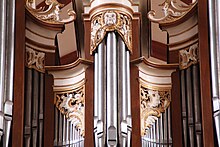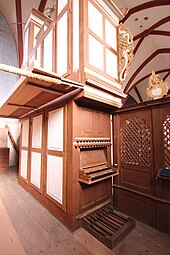Organ of the Altenberg monastery
| Organ of the Altenberg monastery | |
|---|---|

|
|
| General | |
| place | Altenberg Monastery |
| Organ builder | Johann Wilhelm Schöler |
| Construction year | 1757-1758 |
| Last renovation / restoration | 2002–2004 by Förster & Nicolaus |
| epoch | Late baroque |
| Organ landscape | Hesse |
| Technical specifications | |
| Number of registers | 23 |
| Number of rows of pipes | 27 |
| Number of manuals | 2 |
The organ of the Altenberg monastery was built in 1757 by Johann Wilhelm Schöler ( Bad Ems ) and installed in 1758. The parapet organ has 23 registers assigned to two manuals and a pedal . Almost unchanged, the valuable historical instrument is a sounding testimony to late baroque organ building.
Building history
Organ buildings in 1452 and 1653
Two previous instruments were built in 1452 and 1653.
New building by Schöler in 1757
Schöler's organ in Altenberg is still in its early phase. The instrument was designed from the outset to function in a monastery church in terms of its range and volume of sound. After the Seven Years' War , three registers in the substation were replaced by registers designed by Friedrich Carl Stumm ( Rhaunen-Sulzbach ) in 1766 . The reasons for this intervention a few years after the qualitatively excellent new building have not yet been clarified. In the following years only maintenance and small repairs are documented. After the secularization of the monastery in 1802, it passed into the possession of the Prince of Solms-Braunfels, who in 1804 arranged for the Bürgy brothers to renovate the organ . Since then, Protestant services have only been celebrated occasionally and the instrument has hardly been used. As a result, the instrument remained almost unchanged; only the original pedal keyboard was lost. Even the original bellows, windchest and tongues have survived the centuries unscathed.
The relatively delicate and colorful sound of the organ and the small size of the pedals are explained by the liturgical function of the organ, which did not have to accompany a parish singing in the monastery. In the substation, the three registers Mixtur, Rohrflaut 4 'and Vox humana 8' are made in the Stumm construction. Otherwise, all of the registers are original from Schöler. The wooden registers Bourdon grand, Gedackt and Hohlpfeif (from c 1 metal) are covered. Nazard and Salicional (with side whiskers) are conical. The wooden flaut travers is open and sounds Ch 0 from the Hohlpfeif. The Rohrflaut is a pipe blind and soldered up to d 1 . All pedal stops are made of wood: the trombone's goblets are made of spruce, boots and throats are made of oak; Principalbass and Octavbass are open. The manual reeds are divided into bass and treble. The fact that an organ survived a quarter of a millennium without substantial interventions is due to the careful craftsmanship of Schölers, who also only used excellent building materials. On the other hand, the historical circumstances have saved the instrument from major changes.
Renovation, cleaning, repair
The company Gebr. Oberlinger ( Windesheim ) renovated the organ carefully in 1977 and under strict monument preservation principles and cleaned it in 1987 after the organ was damaged by construction work in the church.
Between 2002 and 2004, the company Förster & Nicolaus ( Lich ) carried out repairs without interfering with the original substance.
Disposition since 1757
|
|
|
||||||||||||||||||||||||||||||||||||||||||||||||||||
Technical specifications
- 23 registers
-
Action :
- Tone action: mechanical
- Stop action: mechanical
- Wind supply:
- Three bellows in a separate bellows housing behind the plant
- Wind pressure: 68 mm water column
-
Mood :
- Tuning pitch: a 1 = 410.64 Hz at 15 ° C
- Well-tempered mood
literature
- Hans Martin Balz : The Schöler organ in the former Altenberg monastery near Wetzlar . In: Ars Organi . Vol. 49, 2001, pp. 235-239 .
- Martin Balz: Divine Music. Organs in Germany (= 230th publication by the Society of Organ Friends ). Konrad Theiss, Stuttgart 2008, ISBN 3-8062-2062-X , p. 138 f .
- Jürgen Rodeland: The Schöler organ building workshop in Bad Ems . Katzbichler, Munich a. Salzburg 1991, ISBN 3-87397-512-2 .
- Altenberg Monastery Association (publisher): The Schöler organ in the former Altenberg Monastery . Solms-Oberbiel 2007.
Recordings / sound carriers
- Reinhardt Menger: The Schöler organ, built in 1757 in the former Altenberg monastery . 1978. Organo Phon E 10001, LP (works by LN Clerambault, W. Boyce, CPE Bach, JS Bach).
- Reinhardt Menger: JS Bach works . 1984. Organo Phon NR 90016, LP.
Web links
Individual evidence
- ↑ a b c Martin Balz: Divine Music. Organs in Germany (= 230th publication by the Society of Organ Friends ). Konrad Theiss, Stuttgart 2008, ISBN 3-8062-2062-X , p. 138 .
- ^ Franz Bösken : Sources and research on the organ history of the Middle Rhine (= contributions to the Middle Rhine music history . Volume 7.1 ). tape 2 : The area of the former administrative district of Wiesbaden. Part 1: A-K . Schott, Mainz 1975, ISBN 3-7957-1307-2 , p. 21 .
Coordinates: 50 ° 33 ′ 30.2 ″ N , 8 ° 26 ′ 39 ″ E


